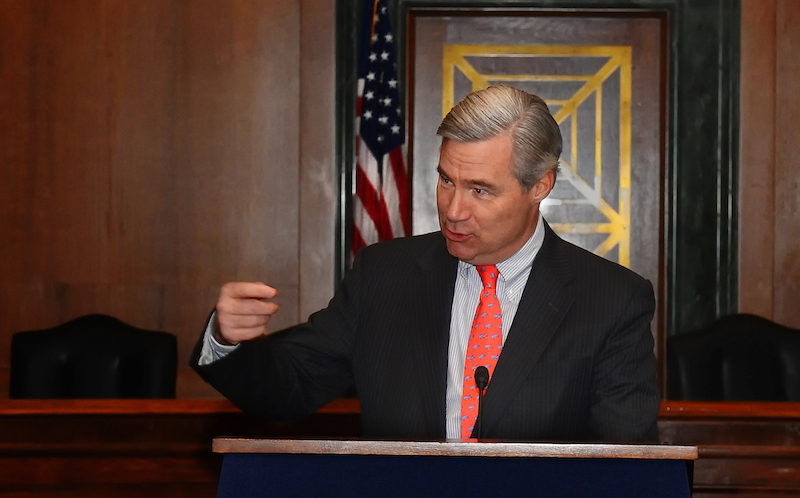
It is time for government to stop private interests from gaining improper influence over regulators.
May I say something shocking? We should all be grateful for regulation.
“Burdensome regulations” are the bane of our economy, as regulation naysayers often declare. But is this really so? Medicines are no longer snake-oil mysteries. Boilers rarely explode in our homes. Automobiles have seatbelts and airbags. Smokestacks have pollution controls. Stockjobbers have a harder time gulling innocent investors. Most insurance policies actually pay when the insured risk occurs. We take for granted the safety and reliability that a regulated world has built.
We also take for granted the extent to which regulation facilitates our country’s economic progress. Regulation helps channel America’s competitive enterprise into good and valuable innovations, instead of into new tricks and traps for consumers, or into new ways of cutting corners. Confidence in our industries grows when consumers know that they can count on the reliability of products. Regulation sets a positive frame for economic growth.
Where there are commonly shared goods at stake—such as clean streams and oceans, or unpolluted skies—there is a perverse economic incentive to abuse those resources, leaving us all poorer. This is the principle that the late Garrett Hardin, a leading ecologist and philosopher, articulated in his famous article, “The Tragedy of the Commons.” Regulation works to constrain this perverse incentive and to protect our common resources.
Critics of regulation often argue that rules can be overbroad, out of date, ineffective, or unduly burdensome. Of course this is true in certain instances. After all, error and obsolescence occur in any human endeavor. There is no denying that to maximize the economic benefit of regulation, standards must be current and efficient.
But my experience is this: When the “burdensome regulations” crowd puts their deregulatory principle into practice, the target is rarely some outdated technical regulation that needs updating. Rather, the target is the Clean Air Act. The target is the law protecting people with preexisting conditions from being denied health insurance. The target is the regulatory bulwark against abuses by the financial services industry, in order to prevent Wall Street from destabilizing the economy.
On the other side of the coin, there is a threat at least as great as burdensome regulation: the threat of regulatory capture—the process by which powerful interests gain improper influence over the agencies that oversee them. This is a phenomenon that can lead to catastrophic consequences, such as the BP Deepwater Horizon oil spill, largely attributed to the then-existing Minerals Management Service’s “dearth of” deepwater drilling regulations; the Sago Mine Explosion, allegedly precipitated by the Mine Safety and Health Administration’s weak enforcement of coal mining regulations; and the global financial meltdown of 2008, widely perceived to have been caused in part by a suite of financial regulators’ lax policies and oversight of large banks. In each of these cases, captured regulatory agencies failed to protect the American people.
Regulatory capture also assaults democratic government. “We the People” pass laws through a democratic process. Elected representatives work the public’s will. Regulations to enforce those laws implement that public interest. All is well—until industries co-opt those regulatory agencies. When they do, the agencies are pried out of the matrix of our government of laws in order to become servants of industry, the public’s voice getting lost in the process.
Policymakers and academics have long recognized the challenges that regulatory capture poses. President Woodrow Wilson explained more than 100 years ago, “If the government is to tell big business men how to run their business, then don’t you see that big business men . . . . must capture the government, in order not to be restrained too much by it?” Regulatory capture has been discussed in the research of Nobel laureate economist George Stigler, in economics textbooks and administrative law treatises, and even in the opinion pages of the Wall Street Journal.
Although the problem of capture can seem intractable, at a U.S. Senate Judiciary Subcommittee hearing I chaired several years ago, I found broad bipartisan agreement on a number of propositions. Specifically, everyone conceded the following points:
First, agency capture is a real phenomenon and a threat to the integrity of government.
Second, the enormous stakes involved for regulated entities create an incentive to gain influence over regulators.
Third, most regulated entities have organizational and resource advantages in the regulatory process, as compared to public interest groups that represent a more diffuse public interest.
Fourth, regulatory processes can be gamed by regulated entities, allowing them undue control over regulation.
Fifth, regulatory capture by its nature happens in the dark, a process that transpires as invisibly as possible.
Sixth, the potential damage from agency capture is enormous.
And finally, effective congressional oversight can keep regulators focused on the public interest and can defend against capture.
Given the general agreement on these propositions, and given the academic history on regulatory capture, there is a surprising dearth of practical study of regulatory capture’s symptoms, effects, and potential cures.
Specifically, there is virtually zero government effort to systematically identify, prevent, and root out regulatory capture. As a matter of good government, this is a problem that must be addressed. Making government work well is one area in which we all ought to have common cause—whether you believe that agency capture is a symptom of excessive or inadequate regulation, regardless of which economic interest you feel poses the greatest risk of capture, and no matter the means by which you think capture should be resolved.
Clearly, those of us in Congress must meet our constitutional obligation to stamp out agency capture whenever and wherever we find it, and we must do this through oversight of the executive branch. But obstruction in Congress by the same interests that perpetuate capture will make effective legislation difficult, at least in the short term. We may need to look to the executive branch to take action.
One proposal that I have raised with officials at the U.S. Office of Management and Budget is to task an executive branch office with investigating and reporting on regulatory capture across the entire regulatory bureaucracy. Such an office could prowl the far and overlooked corners of government, and it could develop methodologies for identifying and dealing with the threat of capture. This proposal, if implemented, would mirror the Regulatory Capture Prevention Act, which I previously introduced in Congress.
The White House Office of Information and Regulatory Affairs (OIRA) also should play a role in rooting out capture, perhaps following a proposal like that advocated by scholars as Professors Michael Livermore and Richard Revesz in their chapter in the book, Preventing Regulatory Capture.
The BP oil spill and the 2008 financial meltdown should teach us that doing spot clean-up after episodic scandals and recurring disasters is no way to govern. It is time to sound a persistent alarm about the prevalence and the risks of regulatory capture, and to find better way to identify and eradicate it.
This essay is part of The Regulatory Review’s sixteen-part series, Rooting Out Regulatory Capture.




